First National Bank of Long Beach
Introduction
Text-to-speech Audio
The building on the northwest corner of Pine Avenue and West First Street in Long Beach was the First National Bank of Long Beach. The clock tower atop the corner of the six-story, brick and steel, French Renaissance Revival style building has been a Long Beach visual landmark since 1907. Due to mergers and sales, the office building has had multiple names, including Bank of America and Enloe Building. Many of the exterior details were obscured by later modernizations but were restored in the 1980s. The building became a National Register of Historic Places entry in 1990 for its distinctive architectural style. It is the only pre-World War I commercial building over three stories tall in downtown Long Beach that survives intact. The ground floor commercial spaces now hold L'Opera (a northern Italian restaurant established in 1990) and Alegria (a nightclub).
Images
First National Bank Long Beach, corner tower & both street sides in 1989 (Bill Doggett for NRHP)
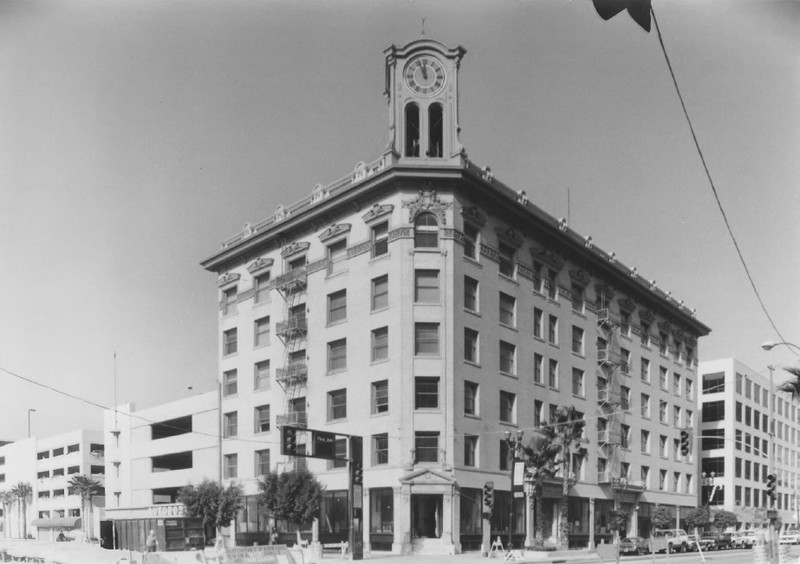
Detail of clock tower atop corner of First National Bank Long Beach (Doggett 1989)
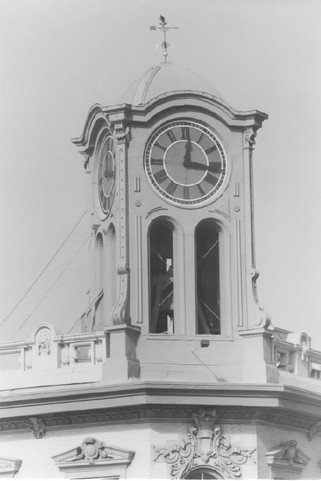
Corner entrance into First National Bank Long Beach building in 1989 (Doggett)
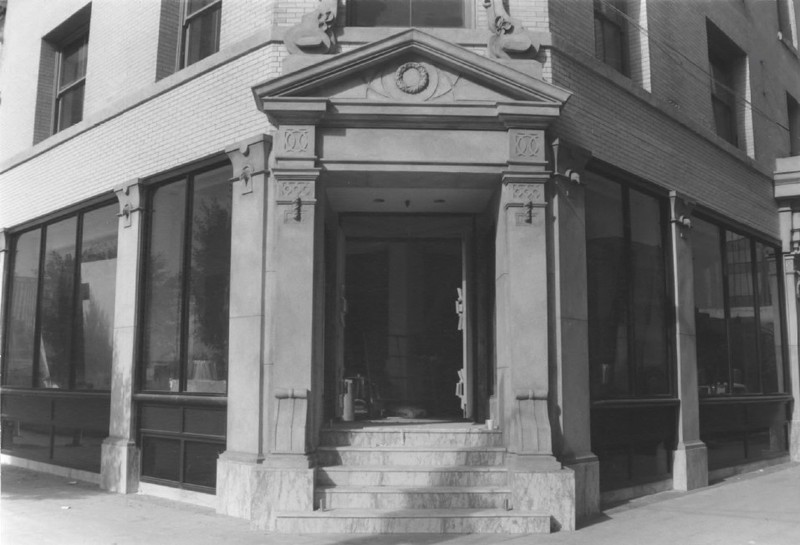
Detail of side entrance; sign in window re: future location L'Opera Restaurant (Doggett 1989)
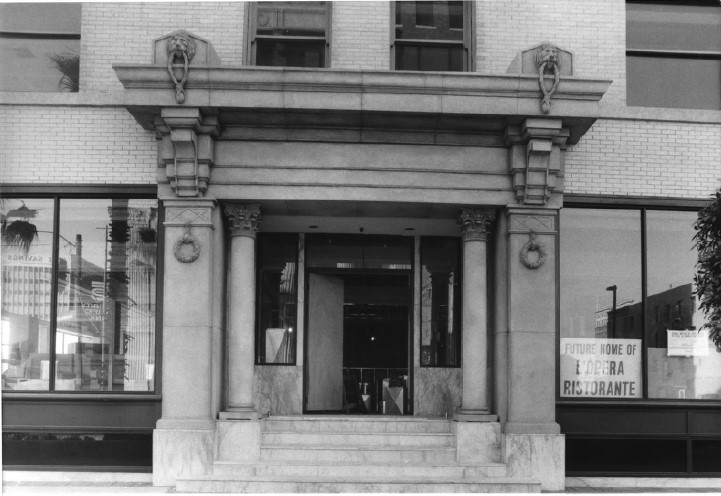
First National Bank Long Beach in historical photograph, from NRHP nomination (unknown circa 1918)
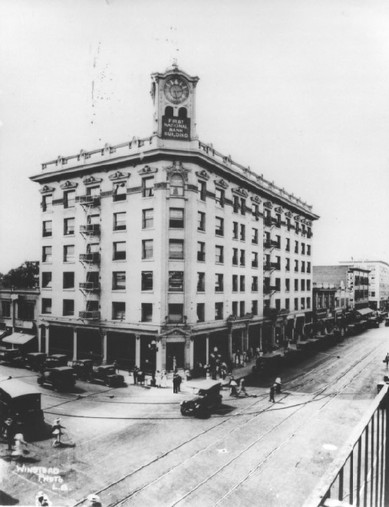
First National Bank (green lines) on 1914 Sanborn map of Long Beach (p. 26)
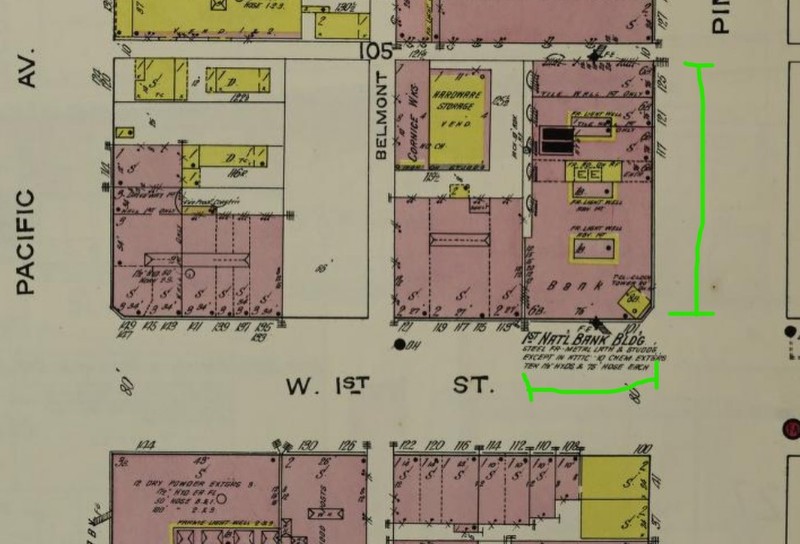
Iowa Villa Hotel (purple arrow) at future location of First National Bank on 1895 Sanborn map (p. 3)
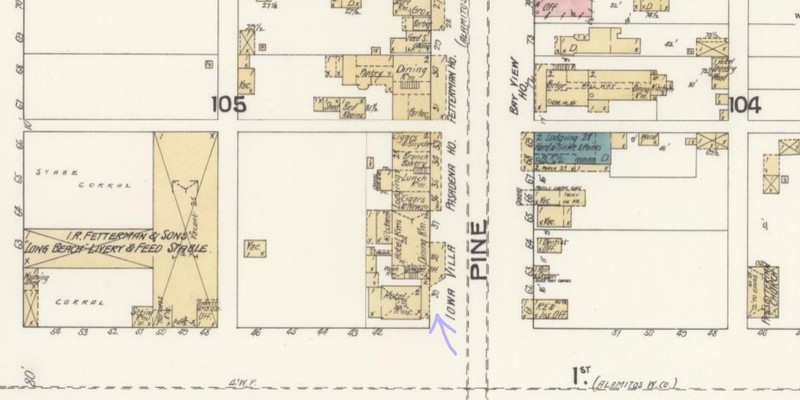
Bank (of America) in "Enloe Building" (green arrow at bank entrance) on 1950 Sanborn map (V. 1, p. 26)
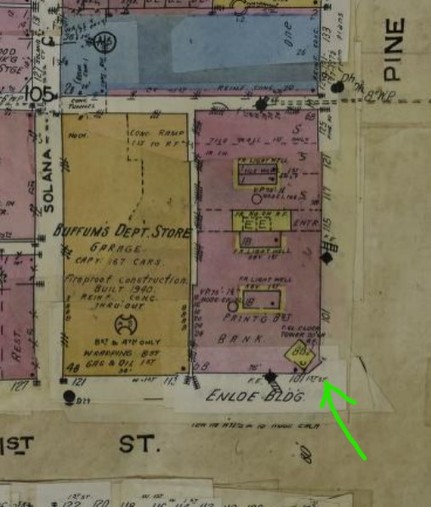
Backstory and Context
Text-to-speech Audio
There were three national banks in Long Beach by 1903; the most, in terms of total deposits, was "National Bank of Long Beach" (circa $314,000), but "First National Bank" was close behind (ca. $307,000). The banks were founded five years apart: 1895 (National Bank of Long Beach) and 1900 (First National Bank, Long Beach). The competing banks ended up having new multi-story buildings constructed across Pine Avenue from each other, on the north side of First Street, just 80 feet apart. National Bank of Long Beach constructing a new five-story brick building on the corner of Pine Ave. and East First Street, replacing an earlier, two-story brick building that held a bank and a meat market built after 1895 and by 1902. In August 1906, the competitor bank, National Bank of Long Beach, moved to its newly built five-story building on the northeast corner of Pine and E. First (100-108 Pine Ave.), along with the Long Beach Savings Bank. Their new building was described in the newspaper as having "exceedingly tasteful and beautiful" interior furnishings and decoration. This building was replaced in 1924 by an even taller high-rise (thirteen stories).
Not to be outdone, First National Bank constructed the six-story building in 1906 that still stands today on the northwest corner of Pine and W. First (101-125 Pine). To make even more of a statement, the 76-foot-tall First National Bank Building was topped in 1907 by a 20-foot-tall clock tower above the corner of the roof at the street corner; the clock, with its four faces nine feet wide, chimed every hour. Before First National Bank built a bank on the northwest corner of Pine and First ("our corner"), there was a wood-frame, two-story hotel named Iowa Villa in this spot, by 1895. Our corner was still occupied by the Iowa Villa in 1902.
The architect of the French Renaissance Revival style structure completed on our corner in 1906 for First National Bank (101-125 Pine Ave.) was the firm Train and Williams (Robert E. Train and Robert F. Williams). The steel-framed structure was encased in buff-colored brick on the street facades and common red brick on the less visible sides. The bank occupied the ground floor of the south half of the structure, entered through an angled entrance near the street corner. There was a secondary entrance to the north of the bank along Pine that led to two elevators; the exterior was decorated with lion's heads and garlands. Three stores were north of the elevator lobby in the Pine Ave. ground floor commercial spaces. The upper five stories above the entire building held office spaces.
By 1916, First National Bank of Long Beach was one of seven banks in the city, whose population had swelled to around 45,000 from under 3,000 in 1900 and 23,000 in 1910. California National Bank moved into the bank space of the building in 1920. Bank of America acquired the property in 1927 and occupied it until 1982; the structure was called the Enloe Building by 1950. It is one of the few commercial buildings in Long Beach that survived a 1933 earthquake intact. The First National Bank building was altered in the late 1930s by removing all but one entrance and covering the exterior ground level with blue tile facing. The parapet along the roofline was removed in 1954. The building underwent massive renovations in the 1980s to return the exterior and parts of the interior to its original style as much as possible while retrofitting to guard against earthquake damage and to install a sprinkler system. The landmark clock was repaired to once again function, although it was awaiting new gear parts in 2022 for additional repairs.
Sources
Anonymous. "Two Banks Move into Fine Quarters." Los Angeles Herald (Los Angeles) August 20th, 1906. 7-7.
City of Long Beach. "Long Beach Special." Los Angeles Evening Herald (Los Angeles) July 1st, 1916. Advertisements sec, 21-21.
City of Long Beach. First National Bank Building (Enloe Building), Global Assets: Historical points of interest. Accessed June 21st, 2023. https://www.longbeach.gov/globalassets/ti/media-library/documents/historical-points-of-interest-gis/first_national_bank_building/.
Grobaty, Tim. "Local history: Pine's oldest building still trying to keep up with the times." Long Beach Post News (Long Beach) September 16th, 2022. online ed.
Hearst, W. R. The American Almanac, Year-book, Cyclopaedia, and Atlas. Edition First. New York, NY. New York American and Journal, Hearst's Chicago American, & San Francisco Examiner, 1903.
Heumann, Leslie. NRHP nomination of First National Bank Building, Long Beach, California. National Register. Washington, DC. National Park Service, 1990.
Sanborn Map Company. Sanborn Insurance Map of Long Beach, Los Angeles County, California. New York, NY. Sanborn Map Company. 1902.
Sanborn Map Company. Sanborn Insurance Map of Long Beach, Los Angeles County, California. New York, NY. Sanborn Map Company. 1914.
Sanborn Map Company. Sanborn Insurance Map of Long Beach, Los Angeles County, California. Vol. 1. New York, NY. Sanborn Map Company. 1950.
Sanborn-Perris Map Company, Ltd. Sanborn-Perris Insurance Map of Long Beach, Los Angeles County, California. New York, NY. Sanborn-Perris Map Company, Ltd., 1895.
National Park Service (NPS): https://npgallery.nps.gov/AssetDetail/NRIS/90001432
NPS: https://npgallery.nps.gov/AssetDetail/NRIS/90001432
NPS: https://npgallery.nps.gov/AssetDetail/NRIS/90001432
NPS: https://npgallery.nps.gov/AssetDetail/NRIS/90001432
NPS: https://npgallery.nps.gov/AssetDetail/NRIS/90001432
Library of Congress (LOC): https://www.loc.gov/item/sanborn00650_009/
https://www.loc.gov/item/sanborn00650_003/
LOC: https://www.loc.gov/item/sanborn00650_012/
